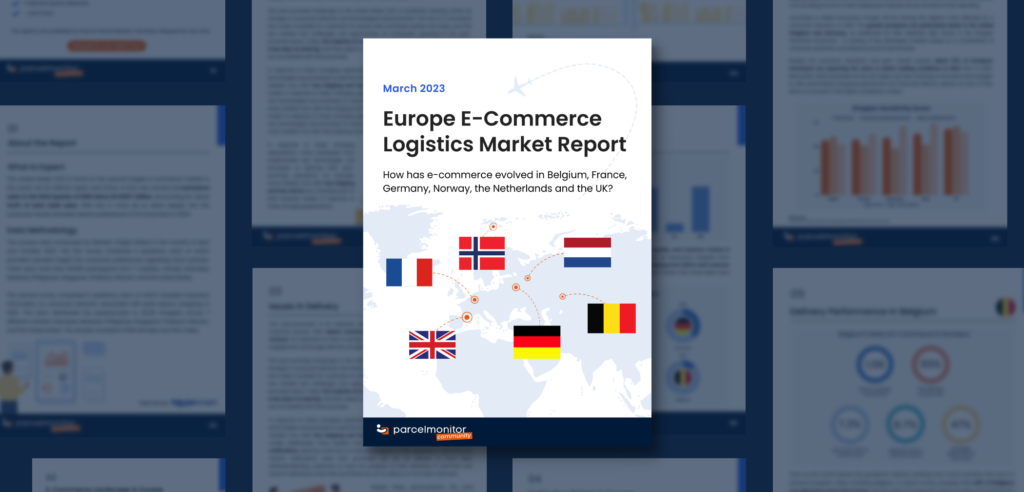The European e-commerce market has had impressive growth in recent years, and this trend is anticipated to continue in the years to come. In one of its recent reports, media partner Parcel Monitor analyzed the delivery performance of six e-commerce markets across Europe, namely Belgium, France, Germany, Norway, the Netherlands and the UK. Key insights covered in the report include:
Issues in delivery performance
Parcel Monitor has identified two main categories of delivery issues: problems originating from the recipient’s end, such as the absence of someone to receive the package, and those arising on the carrier’s end, such as delayed notification of the package’s whereabouts. Last year, carrier-related concerns accounted for 80% of delivery issues in Norway, 57% in the Netherlands, 37% in Germany, 30% in France, 28% in the UK and 12% in Belgium.
Collection points in Europe
The pandemic-induced surge in e-commerce and changing consumer preferences have prompted many merchants to explore alternative delivery options around the world. In Europe, for instance, there are over 336,000 pick-up and drop-off (PUDO) points available, including 43,000 automated parcel machines, according to Last Mile Experts. In fact, the European Union and the UK have experienced an approximately 40% increase in PUDO points since mid-2019.
In 2022, Belgium had the highest utilization rate of collection points (CP) at 8.7%, followed by France (7.3%), Germany (7.1%), and the Netherlands (5.4%). Our historical data indicates a decline in CP usage for all markets, except France, where there was an increase of 14.6% due to La Poste Groupe’s installation of 50 smart lockers in train stations in Paris by the end of Q1 2022. Notably, Germany saw the largest decrease in the percentage of packages transported to collection sites, with a decline of 41.7% from 12.2% in 2021 to 7.1% in 2022. Belgium and the Netherlands also showed a declining trend in CP usage, with decreases of 2.69% and 14.6%, respectively.
Delivery performance in Belgium
In numerous European countries, like Belgium, working from home is still common even as the world moves past the pandemic. According to a recent survey, 46% of Belgians are permitted to work from home, with 2.5 days a week being the ideal schedule. Given that most people spend the year at home, it is not surprising that Belgium’s first-delivery success rate reached 93.2% in 2022.
In Belgium, the average domestic transit time increased from 1 day in 2021 to 1.06 days in 2022, indicating a decline in delivery efficiency. In fact, 12% of delivery problems were the fault of the carriers. Given that just 3.11% of all delivery issues in all of Europe during peak season 2022 were caused by carrier-related factors, this is regarded as being relatively high.
Delivery performance in France
In 2022, the average transit time for parcels in France was 1.91 days, with a 9.8% issue ratio and a first-attempt success rate of almost 91%. The relatively high transit time may be related to the frequent strikes that occur throughout the year. For starters, in November 2022, over 60% of French postal workers participated in postal strikes in the southwest of the country to protest job cuts, pay cuts and unfavorable working conditions, causing package deliveries in and around Bordeaux to be delayed for several days.
Despite France’s continued high usage of collection points (7.3%), there has been a decrease since 2021, which may be attributed to the new Strong Customer Authentication (SCA) rules causing frustration and dissatisfaction among 46% of French consumers. It is reasonable to assume that France’s reduced online purchasing activity in 2022 contributed to the nationwide drop in collection point usage. Further analysis revealed that France had one of the longest durations for packages staying at collection sites, with only 49% of packages being picked up within the first 24 hours.
Delivery performance in Germany
In contrast to France, Germany experienced a reduction in transit time, from 1.3 days in 2021 to 1.22 days in 2022, thanks in part to the coordinated efforts of third-party logistics (3PL) companies to increase the number of warehouses throughout the country. This has resulted in a reduction in shipping distance and time required to deliver goods to consumers.
The first-attempt success rate has remained virtually unchanged over the last two years, with 94.5% in 2021 and 94.9% in 2022. However, Germany’s use of collection points decreased from 12.2% in 2021 to 7.1% in 2022. When it comes to last-mile delivery, German customers prefer home delivery with a required signature upon arrival. According to RetailX, 52% of Germans preferred this option as it provides them with assurance and delivery confirmation. Click-and-collect was chosen by only 6% of German consumers in 2021, with collection points and other unconventional methods also being less popular than home delivery.
To find out more information about the rest of the countries, including Norway, the Netherlands and the UK, download the full report here.


